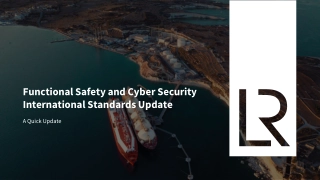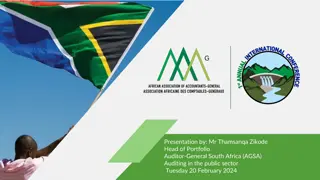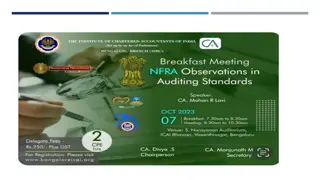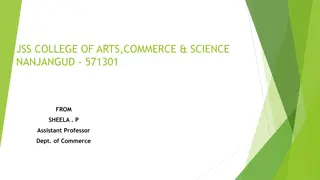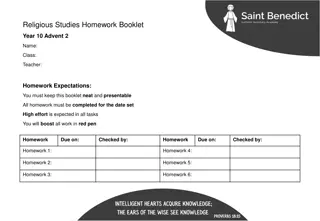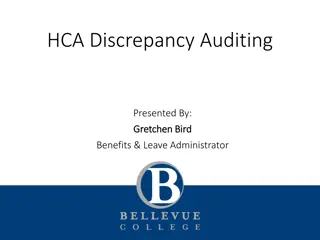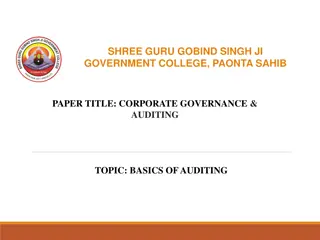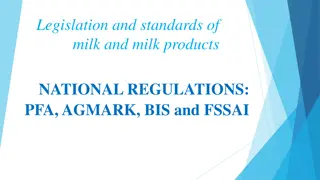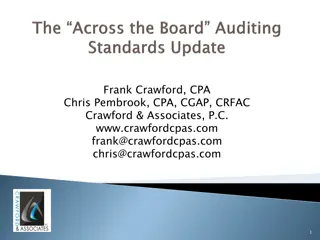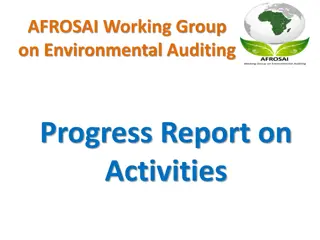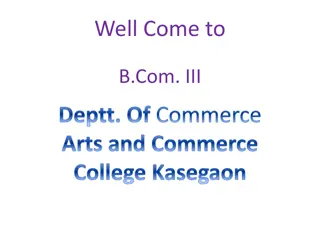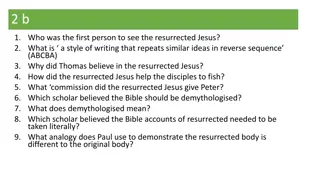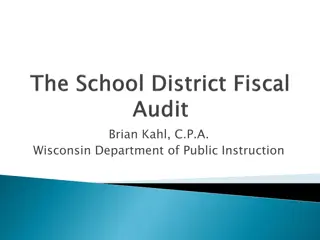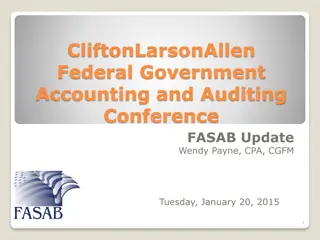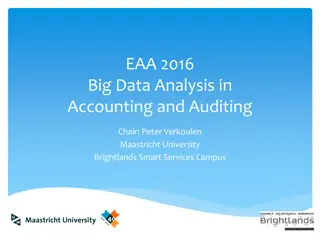Update on New Interpretations and Challenges in Government Auditing Standards
This update covers the new interpretations related to the Yellow Book in government auditing standards. It includes details on conceptual framework implementation challenges, peer reviews, and performance/attest independence. The GAO is developing interpretive guidance on assessing and reporting peer review results and addressing nonaudit services and limited-scope audits. The need to identify threats to independence, evaluate their significance, apply safeguards, and document these procedures is also emphasized.
Download Presentation

Please find below an Image/Link to download the presentation.
The content on the website is provided AS IS for your information and personal use only. It may not be sold, licensed, or shared on other websites without obtaining consent from the author.If you encounter any issues during the download, it is possible that the publisher has removed the file from their server.
You are allowed to download the files provided on this website for personal or commercial use, subject to the condition that they are used lawfully. All files are the property of their respective owners.
The content on the website is provided AS IS for your information and personal use only. It may not be sold, licensed, or shared on other websites without obtaining consent from the author.
E N D
Presentation Transcript
DM # 6192169H Government Auditing Standards Yellow Book Update Page 1
Yellow Book Update New Interpretations Conceptual Framework Implementation Challenges 2
New Interpretations New interpretations 1. Same authority as Yellow Book 2. Presented to Advisory Council 3. Addressed with key stakeholders 4. Posted to GAO website once finalized 3
New interpretations Two new interpretations (draft-pending) 1. Peer Reviews 2. Performance/Attest Independence 4
Interpretation 1 - Peer Reviews The peer review team uses professional judgment in deciding the type of peer review report Types of peer review ratings: 5 5
Interpretation 1 - Peer Reviews GAO is developing interpretive guidance on assessing and reporting on the results of peer reviews in government environment: New report ratings do not change the thresholds for deficiency reporting Matters identified during peer review that are not included in report may be communicated orally or in writing 6 6
Interpretation 2 Performance/ Attest Independence Nonaudit Services and Limited-Scope Audits GAO is developing interpretive guidance on GAGAS paragraph 3.47: Allows Auditors to perform some otherwise-prohibited nonaudit services Prohibits - Clarifies Attest and Performance Audit independence requirements parallel Does not apply to financial statement audits Auditors always still required to assess independence using the Conceptual Framework 7
Conceptual Framework 1. Identify threats to independence 2. Evaluate the significance of the threats identified, both individually and in the aggregate 3. Apply safeguards as necessary to eliminate the threats or reduce them to an acceptable level 4. Evaluate whether the safeguard is effective Documentation Requirement: Para 3.24: When threats are not at an acceptable level and require application of safeguards, auditors should document the safeguards applied 8 8
Conceptual Framework Applying The Framework Threatscould impair independence Do not necessarily result in an independence impairment Safeguards could mitigate threats Eliminate or reduce to an acceptable level 9
Applying the Framework: Categories of Threats 1. Management participation threat 2. Self-review threat 3. Bias threat 4. Familiarity threat 5. Undue influence threat 6. Self-interest threat 7. Structural threat 10 10
GAGAS Conceptual Framework for Independence Assess condition or activity for threats to independence No Threat identified? Proceed Yes Is the nonaudit service specifically prohibited in GAGAS paragraphs 3.36 or 3.49 through 3.58? Yes Yes Is threat related to a nonaudit service? No No Assess threat for significance No Is threat significant? Proceed Yes Identify and apply safeguard(s) Assess safeguard(s) effectiveness Is threat eliminated or reduced to an acceptable level? No Yes Document nature of threat and any safeguards applied Independence impairment; do not proceed Proceed 11
Additional Documentation Requirements 1. Auditors must document assessment of SKE 2. Auditors must document application of safeguards in place
Implementation Challenges Nonaudit services Assessment of SKE (Skill, Knowledge and Experience) SKE is assessed before conceptual framework
Reminder - Continuing Professional Education (CPE) No revision to overall requirements Minimum of 24 hours of CPE every 2 years Government Specific or unique environment Auditing standards and applicable accounting principles Additional 56 hours of CPE for auditors involved in Planning, directing, or reporting on GAGAS assignments; or Charge 20 percent or more of time annually to GAGAS assignments Minimum of 20 hours of CPE each year 14
Where to Find the Yellow Book The Yellow Book is available on GAO s website at: www.gao.gov/yellowbook For technical assistance, contact us at: yellowbook@gao.gov or call (202) 512-9535 15 15
Standardsfor Internal Control in the Federal Government Standards for Internal Control in the Government Going Green
Session Objective: Going Green To discuss GAO s plan to update the Standards for Internal Control in the Federal Government, (Green Book) To discuss why internal controls are a key tool government managers use to Produce reliable financial reports Maintain compliance Achieve operational objectives and mitigate risks To demonstrate 17
Implications of Ineffective Internal Controls 18
Reasons for Green Book Revision Last issued in November 1999 Adapt to a more global, complex, and technological landscape Maintain relevancy to changing standards Harmonize federal standards with the updated Committee of Sponsoring Organizations of the Treadway Commission (COSO) Framework 19
Whats in Green Book for the Federal Government? Reflects federal internal control standards required per Federal Managers Financial Integrity Act (FMFIA) Serves as a base for OMB Circular A-123 Written for government Leverages the COSO Framework Uses government terms 20
Whats in Green Book for State and Local Governments? May be an acceptable framework for internal control on the state and local government level under proposed OMB Uniform Guidance for Federal Awards Written for government Leverages the COSO Framework Uses government terms 21
Whats in Green Book for Management and Auditors? Provides a framework for management Provides criteria for auditors Can be used in conjunction with other standards, e.g. Yellow Book 22
Updated COSO Framework Released May 14, 2013 23
Internal Control: COSO Framework Published by COSO COSO is sponsored by American Accounting Association (AAA) American Institute of Certified Public Accountants (AICPA) Financial Executives International (FEI) Institute of Management Accountants (IMA) Institute of Internal Auditors (IIA) Established: Common internal control definitions Internal control components 24
The COSO Framework Relationship of Objectives and Components Direct relationship between objectives (which are what an entity strives to achieve) and the components (which represent what is needed to achieve the objectives) COSO depicts the relationship in the form of a cube: The three objectives are represented by the columns The five components are represented by the rows The entity s organization structure is represented by the third dimension Source: COSO 25
Updated COSO Framework Retains the five components and adds principles and points of focus Sets out 17 principles Fundamental concepts associated with the components Each principle is supported by related points of focus Represent characteristics associated with the principles 26
Updated COSO Framework: Components of Internal Control 1. 2. Exercises oversight responsibility 3. Establishes structure, authority and responsibility 4. Demonstrates commitment to competence 5. Enforces accountability Demonstrates commitment to integrity and ethical values Control Environment 6. Specifies suitable objectives 7. Identifies and analyzes risk 8. Assesses fraud risk 9. Identifies and analyzes significant change Risk Assessment 10. Selects and develops control activities 11. Selects and develops general controls over technology 12. Deploys through policies and procedures Control Activities Information & Communication 13. Uses relevant information 14. Communicates internally 15. Communicates externally 16. Conducts ongoing and/or separate evaluations 17. Evaluates and communicates deficiencies Monitoring Activities 27
From COSO to Green Book: Harmonization Green Book COSO 28
Green Book Revision Process Retained five original COSO components Adapted COSO Framework s language to make it appropriate for a federal government standard Adapted the concepts for a government environment where appropriate Considered clarity drafting conventions Considered INTOSAI internal control guidance 29
Revised Green Book: Standards for Internal Control in the Federal Government Overview Standards 30
Revised Green Book: Overview Explains fundamental concepts of internal control Overview Standards Addresses how components, principles, and attributes relate to an entity s objectives Discusses management evaluation of internal control 31
Overview: Components, Principles, and Attributes Overview Achieve Objectives Standards Components Principles Attributes 32
Overview: Principles and Attributes In general, all components, principles, and attributes are required for an effective internal control system Overview Standards Principles and Attributes Entity should implement relevant principles and attributes If a principle or attribute is not relevant, document the rationale of how, in the absence of that principle or attribute, the associated component could be designed, implemented, and operated effectively 33
Overview: Management Evaluation Overview Overview An effective internal control system requires that each of the five components are: Effectively designed, implemented, and operating Operating together in an integrated manner Standards Standards Management evaluates the effect of deficiencies on the internal control system A component is not likely to be effective if related principles and attributes are not effective 34
Revised Green Book: Standards Overview Control Environment Standards Risk Assessment Control Activities Information and Communication Monitoring 35
Revised Green Book: Standards Overview Discusses requirements of each component Standards Explains principles and attributes for each component Includes application material for each attribute 36
Standards: COSO vs. Green Book Overview Component COSO Green Book Standards Control Environment 5 Principles 20 Points of Focus 5 Principles 13 Attributes Risk Assessment 4 Principles 27 Points of Focus 4 Principles 10 Attributes Control Activities 3 Principles 16 Points of Focus 3 Principles 11 Attributes Information & Communication 3 Principles 14 Points of Focus 3 Principles 7 Attributes Monitoring 2 Principles 10 Points of Focus 2 Principles 6 Attributes Note: GAO combined COSO s points of focus into attributes 37
Standards: Harmonization from COSO to Green Book Overview Standards Commercial Concepts Government Concepts Board of Directors Investors Oversight Body Stakeholders 38
Standards: Harmonization Example Overview Standards COSO (Principle 2) The board of directors demonstrates independence from management and exercises oversight of the development and performance of internal control. Green Book (Principle 2) The oversight body should oversee the entity s internal control system. 39
Green Book Revision Proposed Timeline Green Book Advisory Council Public Outreach to User Community Exposure (90 day comment period) Finalize May 20, 2013 Summer 2013 Ongoing 2014 40
Green Book Advisory Council Representation from: Federal agency management (nominated by OMB) Inspector General State and local government Academia COSO Independent public accounting firms At large 41
Where to Find the Green Book Once exposed, the Green Book will be on GAO s website at: www.gao.gov For technical assistance, contact us at: greenbook@gao.gov 42


